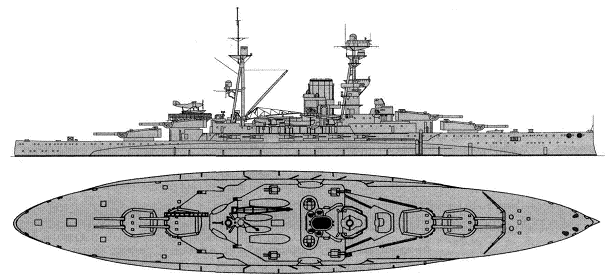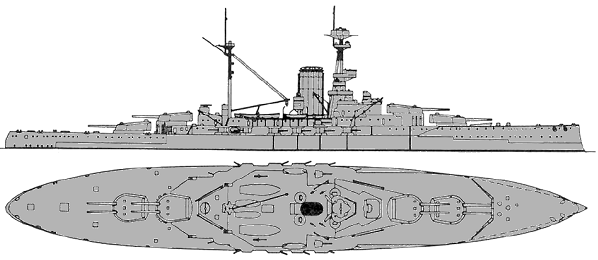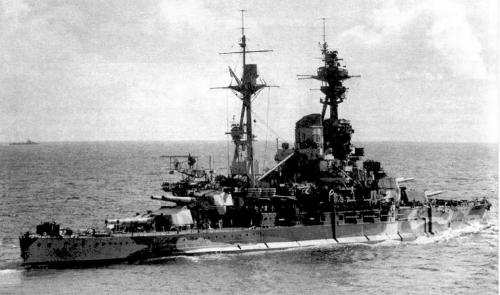
NAVYPEDIA
 Support the project with paypal
Support the project with paypal
Photo

Resolution 1924
Ships
| Name | No | Yard No | Builder | Laid down | Launched | Comp | Fate |
|---|---|---|---|---|---|---|---|
| Royal Oak | 67, 4A, 38, 08 | Devonport DYd | 15.1.1914 | 17.11.1914 | 5.1916 | sunk 14.10.1939 | |
| Resolution | 8A, 1A, 57, 09 | 838 | Palmers, Jarrow | 29.11.1913 | 14.1.1915 | 12.1916 | sold for BU 5.1948 |
| Royal Sovereign | 59, 5A, 89, 05 | Portsmouth DYd | 15.1.1914 | 29.4.1915 | 5/1916 | to Soviet Union 8.1944 - 2.1949 (Архангельск)([Arkhangelsk]), BU 4.1949 | |
| Revenge (ex-Renown) | 98, 2A, 29, 06 | 415 | Vickers, Barrow | 22.12.1913 | 29.5.1915 | 3.1916 | sold for BU 9.1948 |
| Ramillies | 74, 98, 21, 07 | 516 | Beardmore, Dalmuir | 12.11.1913 | 12.9.1916 | 9.1917 | sold for BU 3.1948 |
Technical data
| Displacement normal, t | Royal Oak, Resolution, Royal Sovereign, Revenge: 28000 Ramillies: 29150 |
|---|---|
| Displacement full, t | Royal Oak, Resolution, Royal Sovereign, Revenge: 31000 Ramillies: 33500 |
| Length, m | 190.3 |
| Breadth, m | Royal Oak, Resolution, Royal Sovereign, Revenge: 27.0 Ramillies: 31.3 |
| Draught, m | Royal Oak, resolution, Royal Sovereign, Revenge: 8.70 load Ramillies: 8.39 load |
| No of shafts | 4 |
| Machinery | Ramillies, Revenge, Royal Sovereign: 4 sets Parsons geared steam turbines, 18 Babcock & Wilcox boilers Resolution, Royal Oak: 4 sets Parsons geared steam turbines, 18 Yarrow boilers |
| Power, h. p. | 40000 |
| Max speed, kts | Royal Oak, Resolution, Royal Sovereign, Revenge: 22 Ramillies: 21.5 |
| Fuel, t | 3400 oil |
| Endurance, nm(kts) | 4200(10) |
| Armour, mm | main belt: 330 - 102, upper belt: 152, bulkheads: 152 - 102, turrets: 330 (face) - 279 (sides) - 127 (roof), barbettes: 254 - 178 (over main deck) - 152 - 102 (under main deck), casemates: 152, main deck: 51 - 25 (76 over magazines), upper deck: 38 - 25, casemate roof: 25, longitudinal bulkhead: 38, CT: 279 |
| Armament | 4 x 2 - 381/42 BL Mk I, 14 x 1 - 152/45 BL Mk XII, 2 x 1 - 76/45 20cwt QF Mk I, 4 x 1 - 47/40 3pdr Hotchkiss Mk I, 4 - 533 TT (beam, 20) |
| Complement | 908 - 997 |
Standard scale images

Royal Sovereign 1944

Royal Oak 1939

Revenge 1915
Graphics
Project history
Although a later generation knew them as Royal Sovereign class, Admiralty papers of the 1914-18 period always refer to the 1913 Programme battleships as Revenge class. They were a cheaper design than the Queen Elizabeths, with a speed of only 21.5kts, and were to revert to coal and oil fuel, but in other respects resembled the previous design. During the design stage the aftermost 152mm guns were suppressed and a weatherdeck 152mm gun was substituted, as in Tiger. In January 1915 the design was altered to oil fuel only and machinery power was increased from 31000 to 40000 to increase speed from 21.5kts to 23kts. Fuel stowage changed from 3000t coal and 1500t oil to 3400t oil but the change did little to increase endurance as load tonnage had gone up from 25500t to 28000t. Eight ships were planned but 26.8.1914 work stopped on all new capital ships. The new First Sea Lord, Admiral Fisher, succeeded in getting contracts for two suspended, with a view to redesigning them as battlecruisers of Renown class. Although smaller than Queen Elizabeth the armour was better disposed, with the protective deck moved up to main deck level. Another improvement was to move the 152mm guns further aft, and to ensure that the after pair of guns on either side bore aft. However they were still too close to the waterline, and this was the last class to have main deck batteries of this type. In March 1915 permission was given to fit anti-torpedo 'bulges' to incomplete Ramillies. These were 2.1m wide structures attached to the midships part of the hull and faired into the lines to reduce drag. They were filled with compartments packed wilt steel tubes, oil fuel, water or air, and their purpose was to provide a bursting space for a torpedo warhead before it could inflict crippling damage on the main hull. The 'bulge' extended from the forward torpedo room to the after one and weighed some 2500t, including 773t of tubes (intended to offer resistance to the crushing effect of an explosion) and 194t of wood. The Revenge class were good gun platforms but tended to heel excessively when turning. The 'bulging' of Ramillies had the effect of reversing the original stability requirements, by increasing the beam and raising the metacentre. This gave the ship greater initial stability and improved the trim. However it did have the effect of making her roll too much, and after the war experiments were carried to find an improved form of bulge, and other ships also were so fitted. The expected loss of speed did not occur, and the 'bulged' ships showed much less resistance at speed. On trials Revenge, without 'bulges' and displacing 30750t, made 21.9kts with 42650hp, whereas Ramillies at 33000t made 21.5kts with 42383hp. Unlike the earlier dreadnoughts, which had twin balanced rudders, the new ships were given a single large rudder with a small auxiliary rudder ahead of it, on the centreline as well. This idea was intended to reduce vulnerability of the rudders to damage, to reduce resistance and to improve emergency hand-steering (hand-gear was connected only to the small rudder). In practice, however, the small rudder proved of very little use and it was later removed. The ships were completed with all the latest improvements, including director control for 152mm guns as well as the main armament, although secondary directors were not actually fitted until March-April 1917 (in Ramillies as late as June 1918). In common with all dreadnoughts their pumping, flooding and draining arrangements were extended and improved to cope with underwater damage. Extra 25mm HT plating was fitted on the main deck over the magazines and on the transverse torpedo bulkheads, and flashtight scuttles were provided for both 381mm and 152mm ammunition handling systems.
Protection
Plates of the main belt had equal thickness (330mm) on all height (as against plates on Queen Elizabeth class, to narrowed to top and bottom edges). This belt, 3.89m deep, was extended between "A" & "Y" barbettes. Fwd and aft from it thickness of a belt consistently decreased up to 152mm, and then up to 102mm. In 10.4m from stem and approximately in 4m from stern the belt was closed by 102mm bulkheads. Above the main belt between barbettes "A" & "Y" there was a 152mm upper belt, closed by the bulkheads of the same thickness.
The main change in deck protection became rise of the main armored deck on one level upwards because of what its slopes fell to the bottom edge of an armored belt on a waterline under a much more angle, than on Queen Elizabeth class. It had identical 51mm thickness on flat part and on slopes. There were no slopes over engine rooms, and the armored deck reached the top edge of the main belt. Fwd and aft from "A" & "Y" barbettes the main armored deck was flat, its thickness was decreased to 25mm. Aft from barbette "Y" and up to aft bulkhead under the main deck, there was a middle deck with 25mm thickness, this thickness consecutive raised up to 76 and 102mm from aft bulkhead to aft part over steering gear. Fwd from barbette "A" at a level of a medium deck there was a lower armored deck with 25mm thickness, adjoining to the bottom edge of a belt on a waterline. Its thickness raised up to 63mm between fore bulkhead and stem. There was a 38-25mm upper deck, adjoining to the top edge of the upper belt. At last, the battery of 152mm guns was closed by 25mm deck.
Underwater protection was consisted from 25-37mm longitudinal bulkhead, lasting between barbettes "A" & "Y" and covering machinery, magazines and torpedo rooms. Underwater protection in general repeated accepted one on Queen Elizabeth class, but because of smaller thickness was estimated as weaker.
Modernizations
1918, all: + flying-off platforms on turrets "B" & "X"
2/1918, Revenge; 5.1918, Resolution: bulges fitted, beam was 30.9m, draught was 8.30m, full displacement was 32526ts
early 1920s, all: - flying-off platforms
5/1924, Royal Oak: bulges fitted, beam: 31.1m, full displacement: 32100ts
10/1924, Royal Sovereign: bulges fitted, beam: 31.0m, full displacement: 32474ts
1927, Ramillies: new bulges fitted, beam was decreased to 31.1m
late 1928, all: - 2 x 1 - 152/45, 2 x 1 - 76/45, + 4 x 1 - 102/45 QF Mk V
1931, Resolution: - 1 x 1 - 102/45; + 1 x 2 - 102/45 QF Mk XVII
1931 - 1934, all: - 2 - 533 TT, + 2 x 8 - 40/39 2pdr QF Mk VIII, 2 x 4 - 12.7/62
1934, Ramillies: + 1 catapult (1 seaplane)
8/1936, Royal Oak: main deck was increased to 127mm over magazines and 89mm over engines. - 2 - 533 TT; + 4 - 533 TT aw. Deep draught: 9.60m, displacement: 29950/33240ts.
1936 - 1939, all except Resolution: - 4 x 1 - 102/45; + 4 x 2 - 102/45 QF Mk XVI
1936, Resolution: + 1 catapult E-III-T (1 seaplane)
1936, Royal Oak: + 1 catapult S-II-T (1 seaplane)
1938, Resolution: - 1 x 2 - 102/45, 3 x 1 - 102/45; + 4 x 2 - 102/45 QF Mk XVI
1938 - 1939, all except Royal Oak: - 2 - 533 TT
1939, Ramillies: - 1 catapult, 1 seaplane
6/1941, Royal Sovereign: - 2 x 4 - 12.7/62; + 10 x 1 - 20/70 Oerlikon Mk II/IV
9/1941, Resolution: - 2 x 4 - 12.7/62; + 9 x 1 - 20/70 Oerlikon Mk II/IV, type 279, 2x 285 radars
11/1941, Ramillies, Revenge: - 2 x 4 - 12.7/62; + 2 x 4 - 40/39 2pdr QF Mk VIII, 10 x 1 - 20/70 Oerlikon Mk II/IV, type 279 radar
10/1941, Royal Sovereign: 51mm plates added to main deck over magazines; + 2 x 4 - 40/39 2pdr QF Mk VIII
10/1941, Resolution: 51mm plates added to main deck over magazines; + 2 x 4 - 40/39 2pdr QF Mk VIII, 1 x 1 - 20/70 Oerlikon Mk II/IV, type 273, 284 radars.
late 1941 - mid-1942, Royal Sovereign: + type 273, 279, 284, 2x 285 radars.
1942, Revenge: + type 273, 284, 2x 285 radars
1943, Resolution: - 2 x 1 - 152/45
1943, Revenge: - 4 x 1 - 152/45
6/1943, Ramillies: - 4 x 1 - 152/45; + 10 x 2 - 20/70 Oerlikon Mk II/IV. At this time there were type 273, 279, 2x 282, 284B, 2x 285 radars.
10/1943, Royal Sovereign: - 4 x 1 - 152/45, type 284 radar; + 6 x 2 - 20/70 Oerlikon Mk II/IV, 4 x 1 - 20/70 Oerlikon Mk II/IV, 2x type 282, 284B radars; displacement: 29950/34836ts.
1944, Royal Sovereign: - 4 x 1 - 20/70
1944, Resolution: - 1 catapult (1 seaplane), full displacement: 34700t
1944, Ramillies: + 3 x 1 - 20/70 Oerlikon Mk II/IV, type 650 jammer, full displacement: 35390 t
1/1946, Resolution: 4 x 2 - 381/42 Mk I, 10 x 1 - 152/45 P Mk IX, 4 x 2 - 102/45 Mk XIX, 2 x 8 - 40/39 Mk VIA, 2 x 4 - 40/39 Mk VII, 10 x 1 - 20/70 Mk III, type 273, type 279, type 284, 2x type 285 radars
1/1946, Revenge: 4 x 2 - 381/42 Mk I, 8 x 1 - 152/45 P Mk IX, 4 x 2 - 102/45 Mk XIX, 2 x 8 - 40/39 Mk VIA, 2 x 4 - 40/39 Mk VII, 10 x 1 - 20/70 Mk III, type 273, type 279, type 284, 2x type 285 radars
1/1946, Ramillies: 4 x 2 - 381/42 Mk I, 8 x 1 - 152/45 P Mk IX, 4 x 2 - 102/45 Mk XIX, 2 x 8 - 40/39 Mk VIA, 2 x 4 - 40/39 Mk VII, 10 x 2 - 20/70 Mk V, 13 x 1 - 20/70 Mk III, type 273, type 279, 2x type 282, type 284B, 2x type 285 radars, type 650 ECM suite
Naval service
Royal Oak was the first battleship which was lost in the Second World War. She was sunk 14.10.1939 in Scapa Flow by three torpedoes from German submarine U47. Resolution during of an operation against Dakar has received torpedo hit from French submarine Beveziérs 24.7.1940 and has been hard damaged. She was under repair more than a year. Ramillies was damaged by a torpedo from Japanese midget submarine at Madagascar in May, 942 and has gone out from service till June, 1943. Revenge, Resolution and Ramillies are laid up in 1944. Royal Sovereign was transferred to the USSR on account of reparations from Italy.
Many thanks to Wolfgang Stöhr for additional information on this page.
 HOME
HOME FIGHTING SHIPS OF THE WORLD
FIGHTING SHIPS OF THE WORLD UNITED KINGDOM
UNITED KINGDOM REVENGE battleships (5, 1916 - 1917)
REVENGE battleships (5, 1916 - 1917)

